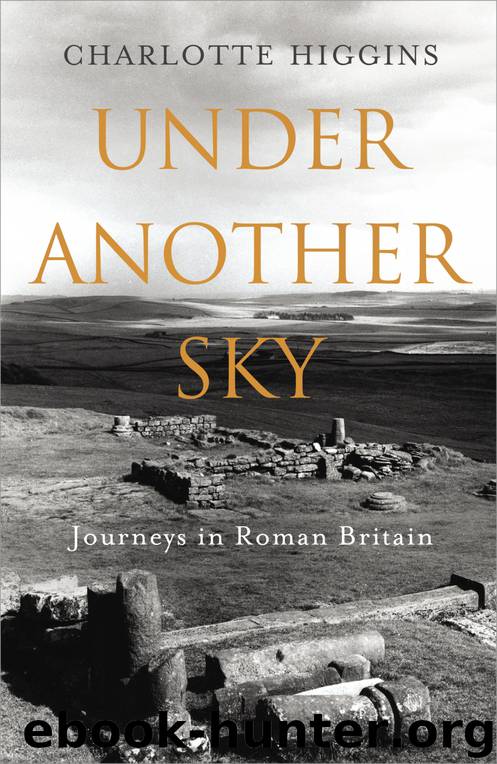Under Another Sky by Charlotte Higgins

Author:Charlotte Higgins
Language: eng
Format: epub
Publisher: Random House
William Stukeley published a tract on Arthur’s O’on in 1720, without, let it be said, having made the journey to Scotland to study it in person. Conjecturing that it was a temple ‘dedicated to Romulus the parent and primitive Deity of the Romans’, he compared it lavishly to Rome’s Pantheon, which he had also never seen. (He included just the faintest pre-emptive acknowledgement that ‘some may think we have done the Caledonian Temple too much Honour in drawing such a Parallel’.) Gordon included a description of it in his Itinerarium, arguing that it was ‘not a Roman Temple for publick Worship’ but, rather, ‘a Place for holding the Roman Insignia’, or legionary standards. However, the two men agreed about its appearance, describing an imposing dome of a building, constructed from large blocks of masonry, some six metres tall. For Stukeley, it was ‘the most genuine and curious Antiquity of the Romans in this Kind, now to be seen in our Island or elsewhere’. It gave its name to the nearby village of Stonehouse, as it is marked on Roy’s map – now the town of Stenhousemuir. (Thus Arthur’s O’on has the distinction of being the only Romano-British monument to have a football team named after it.)
In 1743, however, came disaster. The landowner, Sir Michael Bruce of Stenhouse, decided to build a dam on the Carron, part of the creeping industrialisation of the river that would, a few years later, see the opening of the Carron Ironworks. (These are marked on Roy’s map; by 1814 they would be the biggest ironworks in Europe, producing cannon for the Napoleonic wars under contract to Roy’s employer, the Board of Ordnance.) To build his dam, Bruce needed stone: so he simply demolished the Roman building on the riverbank and used its masonry.
The destruction of what was surely – even without recourse to the hyperbole of Stukeley et al. – one of Scotland’s most important ancient monuments provoked a furious reaction from antiquaries. Chief among them was Sir John Clerk of Penicuik, a Baron of the Exchequer in Edinburgh, whose eventful life had seen him, as a young man, taking violin lessons in Rome with Arcangelo Corelli before being appointed a commissioner for the Act of Union between England and Scotland. He communicated news of the loss in a despairing letter to his friend and fellow antiquary Roger Gale, who had it transcribed into the minute book of the Society of Antiquaries in London: ‘No other motive induced this Gothic knight to commit such a peice [sic] of barbarity but the procuring of as many stones as he could have raised out of his Quarrys there for five shillings … We all curse him here with Bell, Book and Candle.’ Gale wrote to Clerk: ‘I like well your project of exposing your stupid Goth by publishing a good print of Arthur’s Oven with a short account at the bottom of this curious fabrick when intire, and of its destruction … to be done without mentioning any name but the Brutes.
Download
This site does not store any files on its server. We only index and link to content provided by other sites. Please contact the content providers to delete copyright contents if any and email us, we'll remove relevant links or contents immediately.
| Africa | Americas |
| Arctic & Antarctica | Asia |
| Australia & Oceania | Europe |
| Middle East | Russia |
| United States | World |
| Ancient Civilizations | Military |
| Historical Study & Educational Resources |
The Daily Stoic by Holiday Ryan & Hanselman Stephen(3206)
The Fate of Rome: Climate, Disease, and the End of an Empire (The Princeton History of the Ancient World) by Kyle Harper(2984)
People of the Earth: An Introduction to World Prehistory by Dr. Brian Fagan & Nadia Durrani(2680)
Ancient Worlds by Michael Scott(2600)
Babylon's Ark by Lawrence Anthony(2509)
The Daily Stoic by Ryan Holiday & Stephen Hanselman(2434)
Foreign Devils on the Silk Road: The Search for the Lost Treasures of Central Asia by Peter Hopkirk(2414)
India's Ancient Past by R.S. Sharma(2379)
MOSES THE EGYPTIAN by Jan Assmann(2355)
The Complete Dead Sea Scrolls in English (7th Edition) (Penguin Classics) by Geza Vermes(2213)
Lost Technologies of Ancient Egypt by Christopher Dunn(2181)
The Earth Chronicles Handbook by Zecharia Sitchin(2160)
24 Hours in Ancient Rome by Philip Matyszak(2034)
Alexander the Great by Philip Freeman(2017)
Aztec by Gary Jennings(1941)
The Nine Waves of Creation by Carl Johan Calleman(1852)
Curse Tablets and Binding Spells from the Ancient World by Gager John G.;(1825)
Before Atlantis by Frank Joseph(1793)
Earthmare: The Lost Book of Wars by Cergat(1770)
